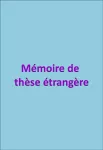| Résumé : |
(auteur) Automatic methods for 3-D reconstruction of man-made objects is an important issue to many users and providers of 3-D city data, including urban planners, architects, and telecommunication and environmental engineers. Buildings are the most prominent and also the most complex man-made objects in 3-D city models, and their 3-D re¬ construction from aerial images requires many components, such as camera models, image processing, stereo matching, texture and color modeling, geometric processing and reasoning, as well as object modeling. This thesis addresses 2-D intermediate level visual processing. The main objective is to derive robust and efficient methods that process the raw image signal over several layers of abstraction to produce meaningful 2-D intermediate level structures. The work has been pursued with an specific application in mind—the automatic reconstruction of houses from aerial images. This application provides complex technical and conceptual challenges and provides a suitable benchmark for designing, implementing, and testing the methods required to solve the task. The presented work focuses on two problems: the generation of a hierarchical, intermediate level representation of the image structures and the design and implementation of a framework for house reconstruction. The symbolic representation is built upon primitive image features — edges, lines, and points — together with their attributes and relations. In the thesis, I emphasize the role that such a representation must take in supporting subsequent processes in instantiating complex objects, even when specific object models are not available. The presented approach to 2-D intermediate level visual processing essentially consists of four components: feature extraction, computation of contour and region attributes, computation of similarity relations, and contour grouping based on similarity. The first processing step detects edge, line, and point evidences, which are then aggregated into a coherent, symbolic representation of edges, lines and points - a contour graph. In a second step, attributes are computed for each extracted edge, line, and point. Of particular importance are the region attributes, which capture the photometric and chromatic surface properties in areas pertaining to both sides of the contours. The computed attributes are then attached to the corresponding feature. This derivation of spectral properties yields important cues, which enables subsequent processes to infer which contours belong to the boundaries of single objects. This specific task is the issue of the third stage. Apart from photometric and chromatic region attributes, geometric criteria are also used to compute a measure for similarity among pairs of edges and lines. The computed similarity relations are represented in the form of a sparse relations graph. The relations, together with the computed similarity score, constitute the graph nodes and compatible relations the graph arcs. The final processing step extracts closed figures (2-D enclosures) by searching for cycles in the relations graph using a standard depth-first search technique. The presented, novel technique to 2-D intermediate level processing has been success¬ fully integrated into a larger system for automatic house reconstruction. The approach relies on hierarchical hypothesis generation in both 2-D and 3-D. The general assumption is that a complete roof consists of a set of planar patches which mutually adjoin along their boundary. Based on this assumption, generic 3-D primitives (denoted 3-D patches in the sequel) are extracted. A 3-D patch is roughly planar and encloses a compact polygonal 2-D enclosure with similar photometric and chromatic attributes. The mutual interaction between planes and 2-D enclosures supports an effective generation of planar roof hypotheses in the image plane. This tight coupling between 2-D and 3-D processing is a major key for the excellent results on house reconstruction. Neither 2-D nor 3-D information alone are sufficient in order to obtain comparable results. By modeling not only the geometry of the roof, but also the spectral properties, complex roof shapes can be reconstructed. An important undertaking, in this thesis, is to show that geometric regularity, although important, cannot serve as sole basis for extracting complex intermediate level structures for which no specific models exist. I demonstrate that this complex problem can be solved by grouping edges and lines be means of similarity in photometric and chromatic attributes. |












